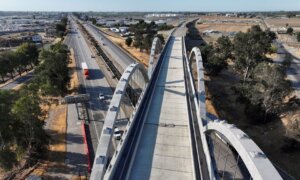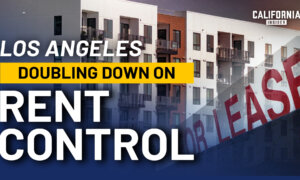When California Gov. Gavin Newsom signed the state budget into law on June 27, he made it contingent on the Legislature passing housing and infrastructure bills aimed at streamlining construction and cutting red tape.
The governor said the $321 billion state budget for the new fiscal year, which began July 1, would not take effect if two trailer bills—AB 130 and SB 131—aimed at boosting housing production and lowering home costs didn’t become law.
Both trailer bills were amended ahead of the budget deadline and signed into law on June 30. SB 131 focuses broadly on infrastructure, while AB 130 is primarily concerned with infill housing in urban areas.
AB 130 passed 28–5 and SB 131 passed 33–1. Sen. Roger Niello, a Republican representing parts of the Sacramento metropolitan area, voted against both bills, saying he disagreed with a provision regarding mortgage lending that he views as unconstitutional.
“I could certainly support most of the rest of it, but because of that one provision, I couldn’t vote aye,” Niello told The Epoch Times on July 3.
The bills amend the 55-year-old California Environmental Quality Act, or CEQA, which requires state and local governments to assess the environmental impacts of proposed projects before approving them, a process that can delay construction and increase housing costs.
“In addition to the Legislature, I thank the many housing, labor, and environmental leaders who heeded my call and came together around a common goal—to build more housing faster and create strong affordable pathways for every Californian,” Newsom said in a statement on Monday.
Referring specifically to SB 131, Newsom said: “Today’s bill is a game changer, which will be felt for generations to come.”
The updates to the CEQA will also apply to infrastructure projects, including infill housing, high-speed rail facilities, utilities, broadband internet, and community facilities—such as public parks and trails, rural health clinics, and food banks—as well as wildfire prevention and farmworker housing.
The legislation also exempts local governments from CEQA review when rezoning neighborhoods to meet state-mandated housing goals.
The bills streamline permitting and approvals, including in high-demand coastal areas governed by the California Coastal Commission, by limiting certain housing-related appeals to the commission and other regulatory actions.
“With these historic laws, we finally have the tools we need to move the needle on affordability in California,” state Sen. Scott Wiener, a Democrat from San Francisco who leads the Senate Budget Committee, said in a statement Monday night. “It isn’t easy to make changes this big, but Californians are demanding an affordable future and it’s our job to deliver for them no matter what.”
AB 130 exempts most urban housing projects from CEQA reviews and requires union-level wages only for high-rise buildings, defined as those taller than 85 feet, and for low-income housing projects.
Assemblymember Buffy Wicks, a Democrat from Oakland, said the bill makes it easier and less expensive for Californians to build, leading to more affordable housing.
“This is what we’ve all been waiting for—a long-overdue step to stop CEQA from being weaponized against housing,” Wicks said in a statement on Monday. “With AB 130, we’re taking a major step toward building desperately needed homes faster, fairer, and with more certainty. This is what our working class families deserve and how we move California’s housing goals from promise to reality.”
California’s housing costs have risen sharply since the 1970s.
“These high housing costs make it difficult for many Californians to find housing that is affordable and that meets their needs, forcing them to make serious trade-offs in order to live in California,” the Legislative Analyst’s Office states. “The state’s housing crisis is one of the most difficult issues facing state policy makers.”
The state’s Department of Housing and Community Development (HCD) has said the problem stems from a lack of construction, limited opportunities, and growing inequality.
“Without intervention, much of the new housing growth is expected to be focused in areas where fewer jobs are available to the families that live there,” HCD states on its website.
HCD also states that too much of people’s income is going toward rent at a time when fewer Californians own homes. Homeownership rates are at their lowest levels since the 1940s, according to the department.
The department points out that Californians make up 12 percent of the nation’s population but account for 22 percent of the nation’s homeless population, adding that cost isn’t the only barrier to housing—discrimination and inadequate accommodations for people with disabilities also play a role.
“Housing costs vary substantially throughout California, with the highest costs in coastal urban areas and the lowest costs in inland rural areas,” the Cal Budget Center states. “But incomes also vary regionally, and areas with relatively lower housing costs also tend to have lower typical incomes.”













